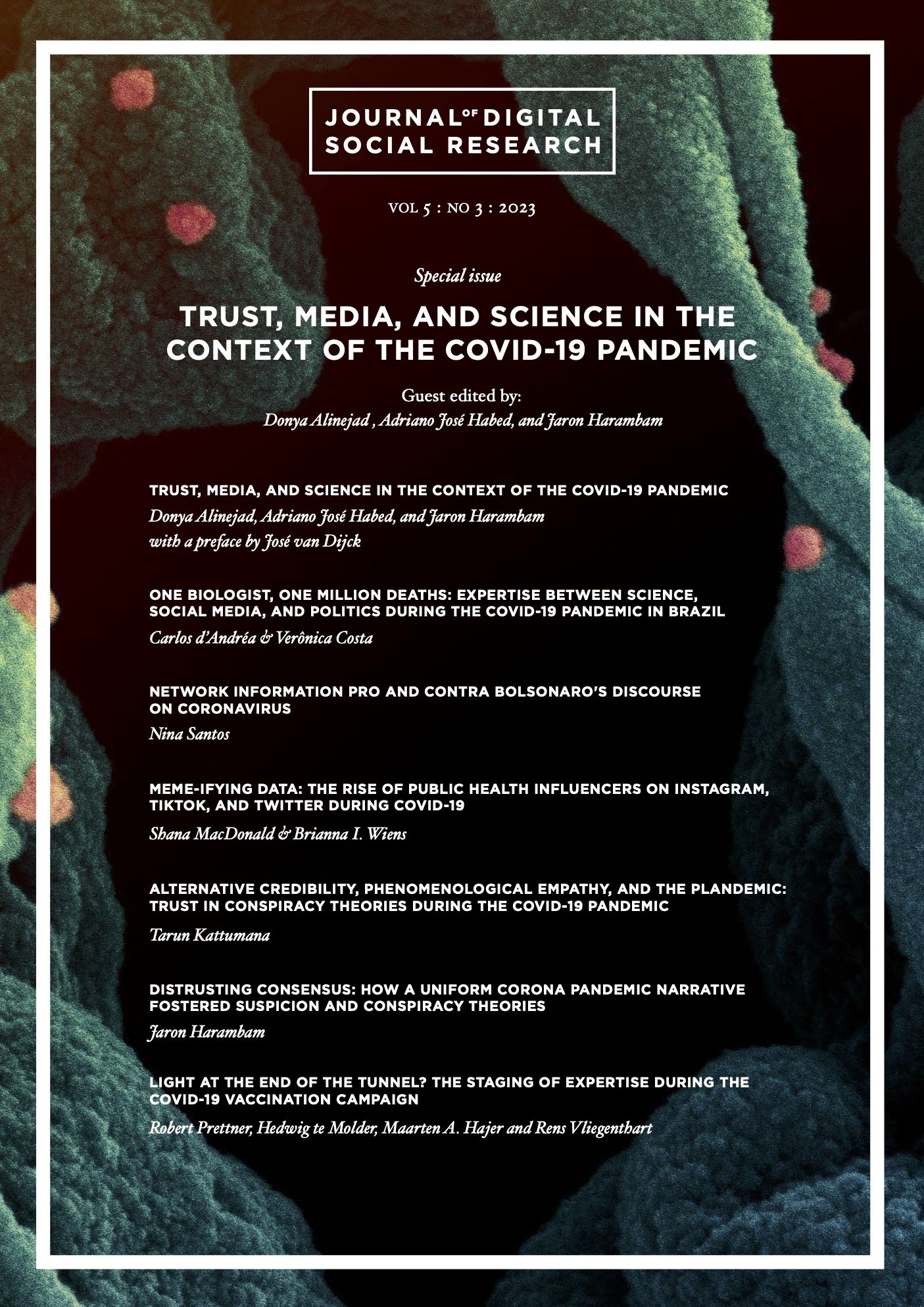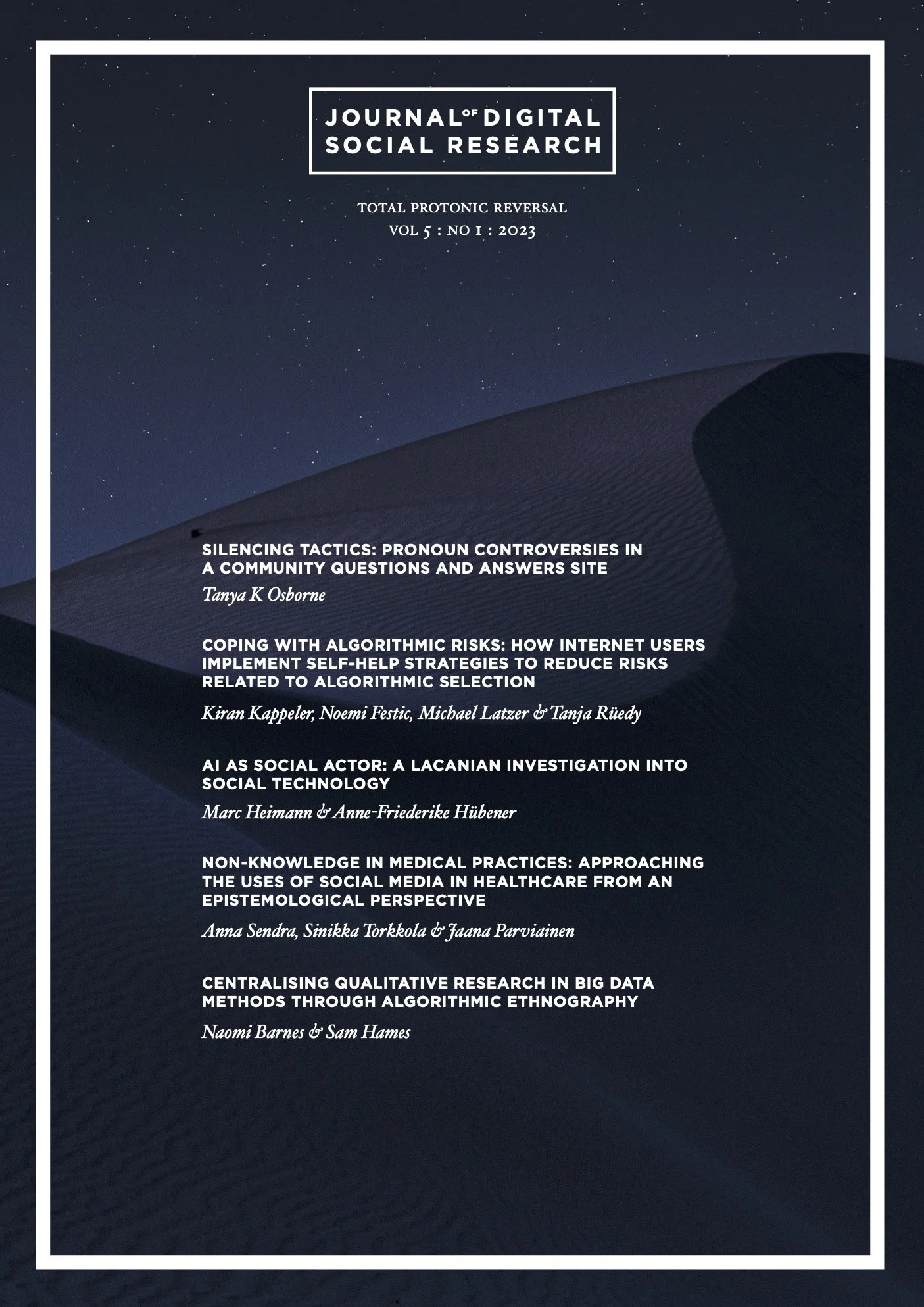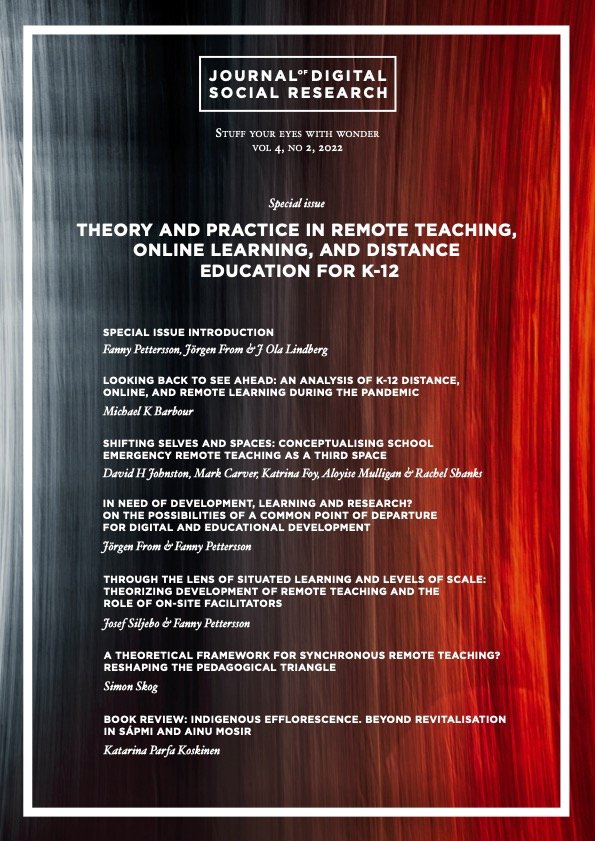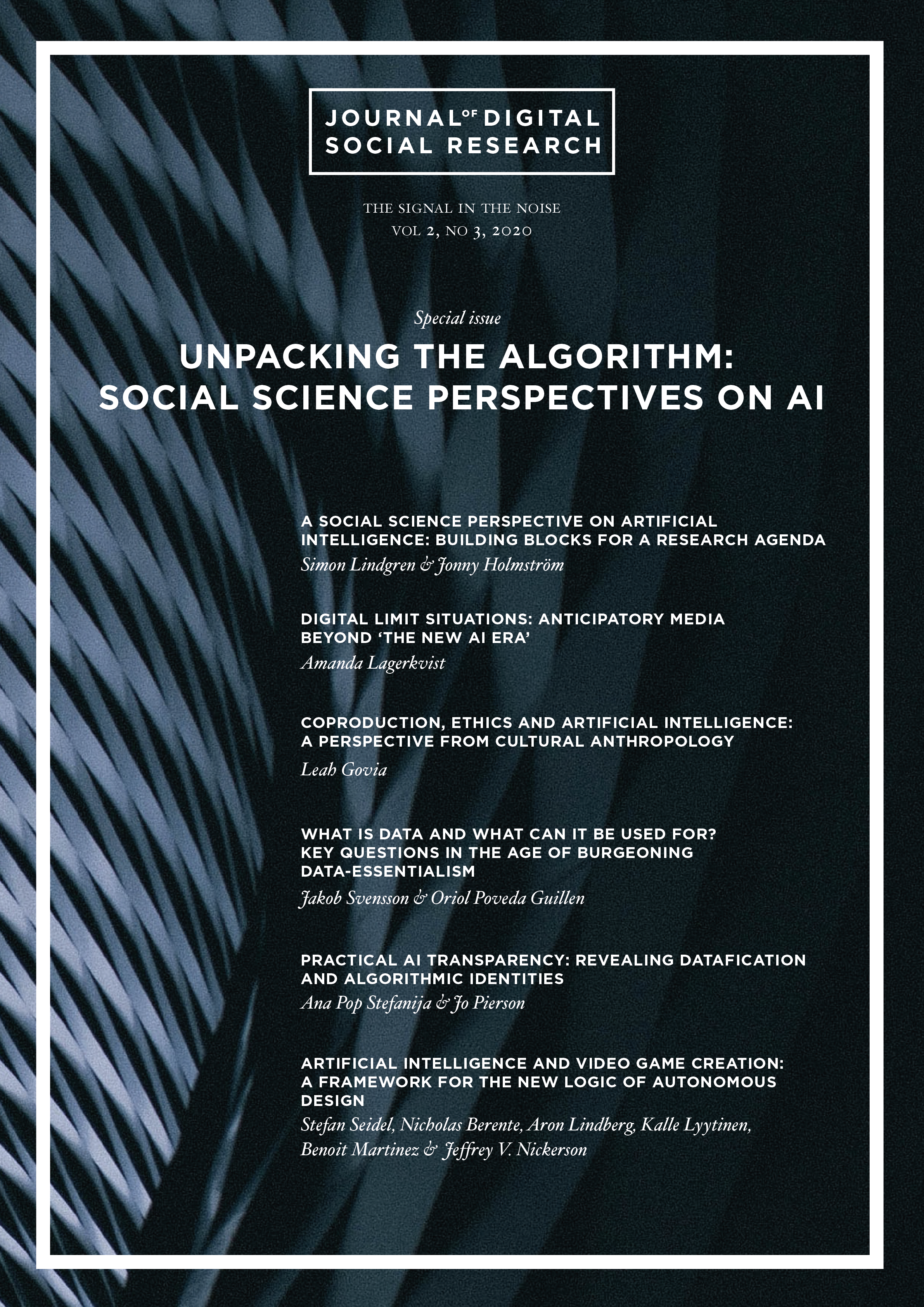Trust, Media, and Science in the Context of the COVID-19 Pandemic
Vol. 5 : No. 3 : 2023
About the issue
The first global pandemic of the information age has revealed how the coordinated spread of accurate information and the communication of relevant expert knowledge rely on functioning media channels, platforms, and institutions. As such, the coronavirus pandemic has exposed, and sometimes even catalyzed, longer-running societal processes through which traditional gatekeepers of scientific truth and expertise have been challenged or side-stepped, as alternative actors and institutions have taken the media stage and influenced policymaking spheres. To what extent has the changing media landscape contributed to (dis)trust in expertise? How do different political contexts shape the dynamics between science, policy, and diverse media publics? And in which ways does the contemporary spread of (mis/dis)information take shape? The articles in this collection address these questions by presenting original empirical analyses from a range of geographic and disciplinary vantage points.
This issue is guest edited by Donya Alinejad, Adriano José Habed, and Jaron Harambam, with a special foreword by José van Dijck.
Blockchain Scenes
Vol. 5 : No. 2 : 2023
About the issue
Over the last fifteen years, the development of blockchain technologies has attracted a large volume of professional expertise, capital investment and media attention. This burgeoning sector of technology practices has coalesced around a few major initiatives (Bitcoin, Ethereum), but it is still moving at a fast pace and its configuration is evolving. If this sector is marked by a variety of technological protocols, financial arrangements and organizational forms, it is also a site of social effervescence. Parties, meet-ups, and the sorts of informal socializing which gather around events and networks of all kinds function to endow the blockchain sector with the characteristics of what, in cultural analysis, are often called “scenes”. The aim of this special issue is to examine the interest of the notion of scene for the analysis of blockchain practices.
This issue is guest edited by Nathalie Casemajor and William Straw.
Vol. 5 : No. 1 : 2023
March 2023
About the issue
This issue of JDSR starts off with an article by Tanya K Osborne on silencing tactics, more specifically how pronoun controversies play out in a community questions-and-answers site. Through digital ethnography, Osborne explores how an international online programming community, Stack Exchange, responded to the challenges of implementing trans and nonbinary inclusive language policies. In the following contribution, by Kiran Kappeler, Noemi Festic, Michael Latzer and Tanja Rüedy, we find an exploration of how internet users implement self-help strategies to reduce risks related to algorithmic selection. Enumerating a number of different risks flowing from algorithmic selection, the authors use survey data from the Swiss online population to show how personal affectedness by algorithmic risks, awareness of algorithmic risks and algorithm skills are associated with the use of self-help strategies like adjusting privacy settings, double-checking of information, and ignoring automated recommendations to cope with the algorithmic risks of surveillance, distorted information, and internet overuse to varying degrees.
Marc Heimann and Anne-Friederike Hübener examine the impact of AI-driven social networks on society and politics. They propose a logical framework using Lacanian psychoanalysis to understand this new social landscape and identifiy a specific form of subjectivity that is amplified by online phenomena like echo chambers and digital identities. In the next article, Anna Sendra, Sinikka Torkkola and Jaana Parviainen explore how social media is transforming illness management for patients. Despite patients seeking information and support online, healthcare professionals often overlook the valuable knowledge generated by patients on social media. The article uses social epistemology and ignorance studies to challenge these views, presenting four ideas to improve healthcare digitisation, including the potential of media and digital health literacy to enhance social media use in healthcare.
In the final article of the issue Naomi Barnes and Sam Hames proposes a methodology for algorithmic ethnography. Their approach analyzes algorithmic discourses while working alongside data scientists, placing people’s understanding of the world at the center of big data research. By using big data methods for qualitative research, this approach offers an affordable way to investigate the technical processes framing online social interactions.
Vol. 4 : No. 4 : 2022
December 2022
About the issue
In the first article of this issue, “Social Media Counterpublics and the Chief Big Foot Memorial Ride”, Ryan T. Goeckner combines qualitative and quantitative approaches to analyse images and engagements stemming from the 2018 Lakota memorial and resistance ride. The focus of the analysis is on the construction of a counterpublic around the ride and on the visual social media strategies by which Indigenous social movements can spread their message to a wider audience. In the next article, “Protesting is not everything: Analysing Twitter use during electoral events in non-democratic contexts”, Hossein Kermani and Fatemeh Rasouli present the result of an analysis of the Iranian Twittersphere during the 2017 presidential election. The authors use framing theory to show that Twitter, in this context, had a very limited impact when it came to protesting the regime.
The third contribution to this issue — “Social [Media] Distancing: On Digital Espionage, Ethnographic Method, and Ethics ‘In the Field’” by Jennifer Cearns — takes a methodological stance and looks at the role of digital ethnography considering social distancing restrictions during the COVID-19 pandemic. Cearns draws on extensive online and offline fieldwork, discusses the interplay between physical proximity and social distance, and problematises the role of digital methods at this nexus. The author introduces the notion of digital distance and argues that it can offer an ethical way of doing ethnographic research with vulnerable communities.
The next contribution is “Humans of Instagram: Exploring Influencer Identity Discourses on Instagram” by Maanya Tewatia and Sramana Majumdar. These authors have carried out in-depth interviews with Instagram influencers and show — through a discourse analysis — how their identities are enabled by the language of the platform. The article critically discusses how the platform as such plays a key part in creating and shaping identities and how the influencers engage in different negotiations, conflicts, resolutions, and performances. The fourth article in this issue is “Hive Mind Online: Collective Sensing in Times of Disinformation”, and was written by Shuyuan Mary Ho, Jeffrey Nickerson, and Qian Zhanga. They introduce the concept of ‘collective sensing’ as a mechanism for detecting disinformation in group communication. Using simulations and multilevel modelling, the authors show how patterns in group communication become more expressive and concentrated following acts of deception. The results indicate that groups can sense deception collectively in relation to disinformation and that collective sensing can be used as a detection method.
The fifth and final article in this issue of JDSR is “The Pepe the Frog Image-Meme in Hong Kong: Visual Recurrences and Gender Fluidity on the LIHKG Forum” by Katrien Jacobs, Degel Cheunga, Vasileios Maltezos, and Cecilia Wonga. This contribution offers a case study analysis of how the digital image-meme of Pepe the Frog was used during the 2019 Anti-Extradition Bill and Law Movement in Hong Kong. Using a mixed-methods approach, the study shows how the meme was imported and adapted by activists to make political statements about gender and democracy in relation to Hong Kong politics. Interestingly — as Pepe was previously used by the xenophobic and misogynistic alt-right in the US — the meme was renegotiated in the Hong Kong context by activists that were largely younger women pushing gender-fluid and emancipatory messages.
Gender, Sexuality, and Embodiment in Digital Spheres
Connecting Intersectionality and Digitality
Vol. 4 : No. 3 : 2022
About the issue
Gender, sexuality and embodiment in digital spheres have been increasingly studied from various critical perspectives: From research highlighting the articulation of intimacies, desires, and sexualities in and through digital spaces to theoretical explorations of materiality in the digital realm. With such a high level of (inter)disciplinarity, theories, methods, and analyses of gender, sexuality, and embodiment in relation to digital spheres have become highly diversified. Aiming to reflect this diversity, this special issue brings together innovative and newly developed theoretical, empirical, analytical, and critical approaches in the study of gender, sexuality, and embodiment in digital spheres. By connecting intersectionality and digitality to one another, it adopts an integrated approach that reflects the intricacy and interconnectedness of social categories and markers of difference, privilege, performance, and discrimination. The contributions explore a range of differently situated digital cultural practices, including intimate and sexual experiences with(in) digital media, online self-presentation, expressions of digital resistance, and forms of backlash and online attacks. What connects all these articles, is their critical approach to intersectional inequalities and privileges in relation to digitality, plus their nuanced perspective on gender, sexuality, and embodiment interferentially. The final article is based on a roundtable discussion and aims to encourage interdisciplinary connections and suggests ways of doing research that builds bridges between academia and activism.
Theory and Practice in Remote Teaching, Online Learning, and Distance Education for K-12
Vol. 4 : No. 2 : 2022
About the issue
This special issue, guest edited by Fanny Pettersson, Jörgen From, and J Ola Lindberg, takes as a point of departure the many situations where digital technology has served as the lifeline or salvation for society. Unexpected and unpredictable situations like catastrophic floods, blizzards, earthquakes, and more recently the Covid-19 pandemic have forced families to stay home, meaning that digital technologies have become important tools for people to work, learn and keep contact with the rest of society. These situations of immediate character have on one hand forced digital and educational development but have on the other hand required an instant readiness for conversion and adjustment without time for reflection.
The special issue is the result of a symposium held in May 2021, Theory and practice in remote teaching, online learning, and distance education for K-12 schools. At the symposium, different strategies to systematically and proactively increase access to education in the context of K-12 using digital technologies was presented and discussed. It brought together representatives from European as well as North American universities, complementing the Nordic countries, and initiated a discussion about the conditions for remote teaching that have bearing on education before, during, and beyond the Covid-19 pandemic.
Vol. 4 : No. 1 : 2022
April 2022
About the issue
This issue of JDSR starts off with an article written by Michael Nycyk, who explores the scholarly concerns and conflicts debated by authors in the field of the use of informant internet data in research. Using published articles, he thematically analyses the emerging patterns of concerns and conflicts over internet data use, and contributes insights into a widely debated and evolving area. The second contribution in this issue, by Naomi Smith and Simon Copland, explores the interesting factor of speed in the spread of memes on Twitter. The authors analyse 'memetic moments' to shed light on the didactic relationship between social media and news media, which helps us take on the complex social issues underpinning those moments.
The third contribution comes from Elizabeth Fetterolf, who approaches the algorithms on a major gig economy platform for care work. The author finds that 'visibility is often related to connectivity, response time, and positive reviews, and who is rendered visible mirrors preexisting inequalities'. In the fourth contribution, Raquel Recuero and Felipe Bonow Soares take us through the spread of disinformation about COVID-19 vaccines in Brazil, exploring how pseudo-science and denunciation of the vaccine influence and validate the populist discourse of the president.
In another case-study, this one focusing on Kuwait, Hesham Mesbah brings us a study of tweeted attitudes towards women parliamentary candidates. Using tweets preceding the parliamentary election in Kuwait, Mesbah shows, among other results, how women candidates were 'praised for acting like men, whereas they are mocked for looking like men'. In the final contribution, Tim Glaesener uses a crowdsourced audit to study the content diversity of Apple's Siri voice assistant, focusing on queries about politically controversial issues. Among other findings, the study shows that fragmentation and concentration can coexist when it comes to search results given by Siri's search algorithm, providing a basis for a clearer understanding of content diversity and providing new insights into the frequency distribution of search results.
Vol. 3 : No. 3 : 2021
October 2021
About the issue
This issue of JDSR again illustrates the width of possibilities in digital social research, both in terms of topics, theories and methods. First up is Blåsjö et al, with an ethnographic study of digital text sharing in business organizations. The study places this literacy practice in workplaces in the foreground, proposes methods for studying this phenomenon, and highlights issues concerning digital text sharing that should be addressed by organizations. Lundgren et al continue the issue with a study on the cultural dimensions of healthcare apps and the changing notions of what "healthcare" and being a "patient" entail. By analyzing three popular Swedish apps and their marketing material through discursive interface analysis of the apps' affordances, the authors show how the apps contribute to producing a marketable narrative about app health care. This narrative includes accessibility, security/safety and personalisation, and is partly produced as an alternative to what is offered by Swedish public health care, addressing users who are young, busy, urban consumers of care.
In the next contribution, Özkula takes on the phenomenon of digital activism. By illustrating the haziness of the concept and the implications of its openness, her study provides a glimpse into the concept's evolution and an illustration of the myriad of conceptual and epistemological fallacies it entails. Borwell et al then take us into the world of cybercrime and the effect on its victims. Their article points to the importance of understanding whether the impact of cybercrime differs from that of traditional crime. Through a literature review the authors point to important future research directions that can serve to address a current knowledge gap in this field. Moving from online victimization to online learning, the next contribution by Stamm et al reflects upon the combination of crowd science and online teaching, or 'Crowd Science infused Learning'. Using an empirical case where an online platform was developed that provided students with training in using different forms of digital data and the assigning of small-scale research tasks, the article provides a critical discussion of the combination of crowd science and online teaching. The authors points to how, despite significant challenges, Crowd Science infused Learning can be a promising approach. Finally, Couldry ends our issue with a review of two recent books, and a further discussion of a third. He thereby addresses questions of the direction of democracy and the impacts of media circulation and data extraction on democratic culture.
Vol. 3 : No. 2 : 2021
September 2021
About the issue
This issue of JDSR begins with a timely analysis of intimacy in the time of COVID-19 by Jamie Foster Campbell and Zizi Papacharissi. In a contribution likely to resonate with many of us in this pandemic time, the authors illustrate how technology sets the tone for interactions and sustain social capital potentially depleted through pandemic conditions of seclusion. To quote the authors, ‘[d]ifferent worlds lurk behind the screen and our collective experience during this COVID crisis has magnified the liquid nature of intimacy, and the role technology plays in our relational lives as we strive for well-being’.
In the following contribution, the focus on the relationship between technology and well-being continues in Dang Nguyen’s study of networks of traditional Vietnamese medicine discourses on Facebook. Among the interesting results, Nguyen finds that social media may replicate, rather than transform, existing social dynamics that have historically enabled the maintenance of traditional forms of medical knowledge.
Using a case-study from Egypt in an exceptional time of educational change, Hany Zayed’s article explores the use of WhatsApp as a tool for qualitative data collection to examine such change, problematising extant methodological categories, entrenched dichotomies, and epistemological questions while informing broader methodological discussions.
Next up, Gondwe et al. provides us with an interesting study of the effect of numeracy on the believability of digital journalism. Using experiments around audience perceptions from the United States, Zambia, and Tanzania, the authors found that numerical values in news stories tended to appeal less to audiences, except for those with a lower understanding of probabilistic and numerical concepts. While numerical values could benefit readers’ trust in news items, the authors point to a potential dichotomy of concern; ‘while numbers can improve the accuracy of a story, the fact that they limit readership and diminish audience appeal renders them useless’.
Finally, Hasinoff and Bivens close this issue of JDSR by offering us a new method for analyzing what a set of apps designed to solve the same problem can tell us about the relationship between app design and ideology. Building on content analysis, interface analysis, and notions of affordances and speculative design, their method, dubbed ‘feature analysis’, is designed to enable researchers to ‘systematically answer questions about how app developers’ design choices reflect existing cultural norms, assumptions, and ideologies’.
Vol. 3 : No. 1 : 2021
March 2021
About the issue
We are happy to present this new issue of JDSR, illustrating the wide scope of current digital social research. Kicking off the issue is Graßl et al. with an analysis of design patterns in online cookie consent requests. They show how ‘dark’ design choices can nudge users towards privacy-unfriendly options, thereby highlighting the work which remains to ensure meaningful choices for internet users in relation to their online preferences. Crucially, they also offer some paths towards better fulfilment of EU policy goals in this area. Meanwhile, Soudias’ contribution offers a strong call to action for understanding public libraries as non-commercial digital arenas furthering the digital commons. Soudias argues that libraries can mobilise to assume a dual role of being a bulwark against the commodification of knowledge, while also contributing to the production of freely and openly accessible knowledge. Furthermore, in their contribution,
Casemajor and Rocheleau analyse the vitality of discussions regarding a memorial to the victims of communism in Ottawa. They develop the theoretical foundations of cascade models with perspectives from platform studies, bringing new insights into issues of concentration of media ownership, algorithmic news processes, grassroots engagement and more. Johanssen, in turn, brings a psychoanalytic perspective on datafication while showing how our relationship to data can be described as a perversion characterised by dominance, exploitation and dehumanisation, but also by care, love, and idealisation. In this case, the platform, and its owners and developers are ‘the perverts’, while we as users are active participants in the perversion. Beyond the perhaps fitting self-reflection that this diagnosis may cause in us as platform users, it also offers ‘a complex conceptualisation of the interplay between affirmation, attraction and exploitation that is immanent to platforms and users today’.
Next up, Pournaki et al. gives us ways to analyse a specific platform in a more practical sense, by contributing the open-source interface ‘the Twitter Explorer’, allowing scientists to explore Twitter data through interactive network visualisations. This interface lowers the technological barriers of data-driven research and can further the type of interdisciplinary research and new perspectives that JDSR is all about. Rounding up the issue, and connecting to many of the themes above, Demertzis et al. analyse privacy attitudes and behaviours of internet users in Greece. Through locating connections between different levels of digital literacy and privacy attitudes they highlight three important imperatives: the need for legislation and regulation; information and digital literacy; and algorithmic transparency through explainable AI.
Unpacking the Algorithm:
Social Science Perspectives on AI
Vol. 2 : No. 3 : November 2020
About the issue
This special issue collects six articles tackling artificial intelligence (AI) from a social science perspective. The diverse set of contributions not only illustrates the potential, importance, and breadth of social science research in this area, but also sketches the outlines of a research agenda developed by Lindgren & Holmström in the special issue introduction.
Highlighting the discursive self-presentation of AI, Lagerkvist's article problematises how AI mythologically constructs its futures as inevitable. Similarly, Svensson and Poveda Guillen's article aligns with a view of data and algorithms as dynamic actants, rather than as objective and firmly-set entities, developing a critique of data-essentialism.
Furthermore, Govia's article targets assumptions of technological determinism and shifts the focus towards everyday interactions with AI systems and processes, thereby contributing to a situated understanding of AI. Similarly Seidel et al., writing about AI in video game design, apply a contextualised perspective where the autonomous design tools are seen as participating agents in the design process. The article by Pop Stefanija and Pierson emphasises how the present data landscape demands continuous adaptation and smart combinations of both new and existing research methods.
We hope that this special issue of JDSR will help define what a social science of AI could and should entail, and that it will also stimulate further discussions about the role of social science perspectives in both intra- and interdisciplinary AI research.
Vol. 2 : No. 2 : 2020
September 2020
About the issue
This issue of JDSR includes a diverse and exciting range of research. Peter Chow-White, Alberto Lusoli, Vu Thuy Anh Phan & Sandy Edward Green explore the social construction of blockchain and Bitcoin in mainstream and specialized media, providing an interesting analysis of a complex and multifaceted debate. Nora Madison and Mathias Klang challenge the criticism that has been leveled against online activism as lazy, offering instead a more nuanced and complete picture of what they see as playing a ‘vital role in the arsenal of the activist’. Combining law and digital methods, Johan Lindholm explores what exactly is and isn’t global about the field of sports law by analyzing conversations about sports law on Twitter. Finally, Mario Khreiche reviews Inhuman Power: Artificial Intelligence and the Future of Capitalism, by Nick Dyer-Witheford, Atle Mikkola Kjøsen, and James Steinhoff. We believe these contributions highlight the dynamic character of digital social research and the value of a truly cross-disciplinary journal like JDSR.
Doing Digital Ethnography:
Private Messages from the Field
Vol 2 : No 1 : February 2020
About the issue
This special issue, guest edited by Crystal Abidin and Gabriele de Seta collects the confessions of five digital ethnographers laying bare their methodological failures, disciplinary posturing, and ethical dilemmas. The articles are meant to serve as counseling stations for fellow researchers who are approaching digital media ethnographically. On the one hand, this issue’s contributors acknowledge the rich variety of methodological articulations reflected in the lexicon of “buzzword ethnography”. On the other, they evidence how doing ethnographic research about, on, and through digital media is most often a messy, personal, highly contextual enterprise fraught with anxieties and discomforts. Through the four “private messages from the field” collected in this issue, we acknowledge the messiness, open-endedness and coarseness of ethnographic research in-the-making.
“Laying bare our fieldwork failures, confessing our troubling epistemological choices and sharing our ways of coping with these issues becomes a precious occasion to remind ourselves of how much digital media, and the ways of researching them, are constantly in the making.”
Conceptualising Digital Social Research
Vol. 1 : No. 1 : September 2019
In this inaugural issue some of the leading researchers in digital social research reflect upon the characteristics, directions, opportunities and challenges of their field. It tells of both past experiences, current issues and future paths. For the journal, this issue represents both a mission statement and an attempt at conceptualisation – delineating the field in which the journal will exist and expressing its role within this field. The impressive range of contributions and contributors reflects the wide scope of the journal and we hope it will inspire others to engage in a creative dialogue about the field and its implications.
“There lies great scholarly potential in bringing data-driven computational approaches into closer contact with social theory, but only if such approaches are given a critical framing.”
















